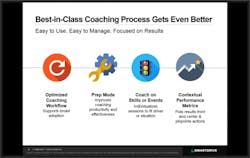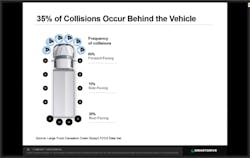SmartDrive enhances in-cab video, driver coaching services
SmartDrive Systems rolled out improvements to its in-cab video and driver coaching services, not only expanding the video-storage capability of its technology package to 16 days but also introducing “video on-demand” capabilities with a “shopping cart” style for video ordering.
The company is also enhancing its “coaching workflow” process by adding more contextual driving analytics to its system while adding a “skills-based” coaching mode to provide a more “individualized” approach to truck driver reviews.
“We believe the [trucking] industry is in a process of transformation, with video in the center of that,” noted Melissa Purcell, SmartDrive’s vice president of marketing and analytics, during a webinar with customers and reporters this week.
“But we also understand it takes more than video to deliver results for fleets,” she stressed. “Today, fleets grapple not whether video itself is right for them but what video solution is right for them.”
Purcell said particular questions more fleets are asking regarding in-cab vide systems are: Am I getting the full value of my investment in it? How can video make my “team” more effective? And for those fleets with a solution already in place, how can video go beyond just collision recording and look at worker’s comp claims along with policy compliance related issues.
Mark Freitus, the company’s vice president of product management, noted during the webinar that providing more “upfront” contextual analysis of driver behaviors is key to help fleets achieve those goals.
“Fleets don’t have a lot of time to perform coaching sessions with drivers,” he explained. “So we’re adding a coaching ‘queue’ that enables [fleet] customers to identify what data is pertinent to them – the drivers with risks identified by the video, aligned with safety policies of the company that is already inputted into the system”
That provides what Freitus believes is a more “task-oriented” view of driver video data tailored to the individual supervisor – the items he or she needs to focus upon, helping optimize their time.
“We want to make sure information presented succulently, quickly, with no need for guesswork,” he added.
Freitus noted that also means sharing recorded information with drivers that is “great stuff” – the things they did right – so it can be presented back to them as a “kudo.” Providing more “contextualized” data also enables to managers to “have a higher level conversation” with drivers about what need to work on.
“They don’t just want to talk about what’s on the video,” he emphasized. “We want to provide data about the driver’s overall safety performance as well: about the great things they’ve already done.”
Extended video storage capacity also helps in regard to offering more “contextualized” analysis, too, Freitus said.
“While can have G-Force triggering [of video recording], there are many other situations where G-Forces are low,” he explained. “So to record and make that information available to fleets, we need to have more storage. That’s why we are extending to 16 days of on demand video storage that they can pull whenever needed. That’s great for fleets with high driving hours per day and for fleets that have incidents and don’t learn about them until much later.”
Along with that are rear- and side-view video recording capabilities, as Freitus said SmartDrive’s data shows that 20% of collisions involving trucks are rear-end incidents, with 15% of them “side-swipe” events, wide side-swipes an example of a low G-Force incident.
He noted that one SmartDrive customer, Bulldog Hiway Express, saved $26,000 by using rear-facing video to identify a vehicle that rear-ended one of their tractor-trailers.
Taken together, SmartDrive said its enhancements affect a wide swath of its system’s capabilities:
- It now can pair exception-based recording with optional digital video recording for “DVR-like” functionality, providing full situational context to fleets;
- Expands recording duration and provides fleets the option to select from 100 hours (approximately eight days) to 200 hours (approximately sixteen days) of additional video context based on fleet needs;
- Ensures video will not be overwritten, which is critical for fleets that do not return to home locations frequently or are required to maintain more video by regulations like CA PUC General Order 172;
- Protects fleets in costly low impact collisions like side-swipes and backing accidents, and no-impact incidents including security and theft situations, compliance audits, workers compensation claims and delivery verification ;
- Integrates contextual performance metrics throughout the coaching workflow process so key performance indicators [KPIs] used by fleets are placed front and center for coaches
- Driver scorecards now include “trended performance” data, coaching history, and peer benchmarking in order to pinpoint areas for improvement, helping speed up coaching sessions while making them more productive;
- Offering a “Prep Mode” to provide an easy-to-use workflow to enhance coaching preparation, enabling coaches to add notes for review by colleagues if necessary or give “kudos” for outstanding driving performance;
- Skills-based or event-based coaching options provide the flexibility to individualize sessions to the needs of the coach or driver;
- Mobile support enables coaches to view video away from their desk, providing access when and where they need it most;
- “Shopping cart” functionality allows fleets to order extended recording or on-demand video immediately when needed or schedule in advance, track the order and receive email status updates;
- Map view of events makes it easy to pinpoint and select appropriate order timeframes;
- Offering up to 24 hours of video for order, providing fleets broad flexibility to support collision investigations, workers compensation or compliance issues, virtual ride-alongs or security related incidents.
About the Author
Sean Kilcarr
Editor in Chief
Sean Kilcarr is a former longtime FleetOwner senior editor who wrote for the publication from 2000 to 2018. He served as editor-in-chief from 2017 to 2018.


